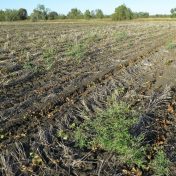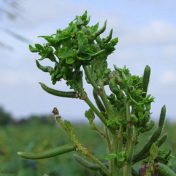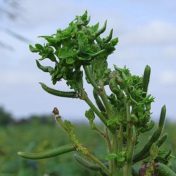More growers are planting canola in southern Queensland this season, so it’s important to be on the lookout for turnip yellows virus (TuYV) – one of the main viral threats to canola. What is TuYV and why does it matter? TuYV is a persistent virus that affects canola and other brassica crops. It is transmitted by green peach aphids (GPA,… Read more »
The recent declaration of El Niño conditions for eastern Australia means an increased chance of below average rainfall. Historically, these conditions can lead to more severe outbreaks of tobacco streak virus. However, with forward planning and selection of suitable sunflower hybrids, the risk of economic impacts from TSV can be avoided. If sunflowers crops are planned for early 2024 in… Read more »
Key points: There was a resurgence in tobacco streak virus (TSV) disease in mungbeans in early 2020 TSV is restricted to central QLD and closely related to the distribution of parthenium weed Growers are encouraged to avoid areas of dense parthenium to reduce risk In autumn of 2020, tobacco streak virus (TSV) was found to be common in all mungbean… Read more »
Phytoplama has been reported in second flower flushes in mungbeans, and also in harvested mungbean regrowth! So far the overall incidence of phytoplasma has been lower than this time last year, but growers and consultants are urged to keep monitoring their crops for the first symptoms of this disease, and to report any outbreaks. Many January-planted mungbean crops are at… Read more »
Last summer saw unprecedented levels of phytoplasma in summer pulses/legumes (including chickpeas, mungbeans and pigeon peas) in all cropping regions in eastern and northern Australia from the Ord Irrigation area (WA), Burdekin/Atherton Tablelands (NQ), to central NSW. The most likely insect vector is the brown leafhopper Orosius orientalis, which has been detected in recent (2017) spring crops. While plantings of… Read more »
Phytoplasma (a specialised bacteria infecting plants) has been widely reported in spring-planted mungbeans from Central Queensland to North Western NSW (Moree and Narrabri) and all areas in between. Symptoms include masses of small deformed leaves, flowers and pods, plants remaining green at harvest, and possibly an increased incidence of puffy pod. While in previous recent summers, moderate to high levels… Read more »






